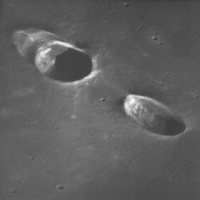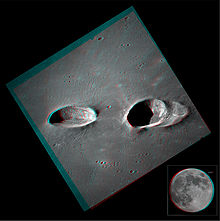- Messier (crater)
-
Messier (crater) 
Messier (right) and Messier A (left) from Apollo 11. NASA photo.Coordinates 1°54′S 47°36′E / 1.9°S 47.6°ECoordinates: 1°54′S 47°36′E / 1.9°S 47.6°E Diameter 9 × 11 km Depth 1.3 km Colongitude 313° at sunrise Eponym Charles Messier Messier is a relatively young lunar impact crater located on the Mare Fecunditatis. The crater has a discernible oblong shape that is not caused by foreshortening. The longer dimension is oriented in an east–west direction.
Just to the west lies Messier A, a similar-sized crater with an oblong, doublet form. The longer dimension of this crater is oriented north–south, at right angles to Messier. This crater also has a curved bulge extending to the west.
The interiors of Messier and Messier A have a higher albedo than the surrounding mare. There is also a dark streak in the center of each crater. Two prominent, nearly linear rays extend westwards from the rim of Messier A, continuing over 100 kilometers towards the east edge of Mare Fecunditatis. The mare surface around the craters is also lightly marked by rays from other craters.
It is theorized that Messier crater was formed by an impact at a very low angle, and that Messier A could have formed following a rebound by the impacting body. The low angle of impact may also explain the asymmetrical ray system.
To the northwest of Messier A is a long, narrow rille.
This crater is named in honor of the French astronomer Charles Messier (1730–1817).[1]
Contents
Satellite craters
By convention these features are identified on lunar maps by placing the letter on the side of the crater mid-point that is closest to Messier.
Messier Latitude Longitude Diameter A 2.0° S 47.0° E 11 x 13 km B 0.9° S 48.0° E 6 km D 3.6° S 46.3° E 8 km E 3.3° S 45.4° E 5 km J 1.5° S 52.1° E 4 km L 1.2° S 51.8° E 6 km The following crater has been renamed by the IAU.
- Messier G - See Lindbergh (crater).
Messier A has been called W. H. Pickering, but this was never officially sanctioned by the IAU. A different crater has since been named for Pickering.
References
- ^ Schmadel, Lutz D.; International Astronomical Union (2003). Dictionary of minor planet names. Berlin; New York: Springer-Verlag. pp. 592–593. ISBN 978-3-540-00238-3. http://books.google.com/books?id=KWrB1jPCa8AC&pg=PA592. Retrieved 9 September 2011.
Lunar crater references
- Andersson, L. E.; Whitaker, E. A., (1982). NASA Catalogue of Lunar Nomenclature. NASA RP-1097.
- Blue, Jennifer (July 25, 2007). "Gazetteer of Planetary Nomenclature". USGS. http://planetarynames.wr.usgs.gov/. Retrieved 2007-08-05.
- Bussey, B.; Spudis, P. (2004). The Clementine Atlas of the Moon. New York: Cambridge University Press. ISBN 0-521-81528-2.
- Cocks, Elijah E.; Cocks, Josiah C. (1995). Who's Who on the Moon: A Biographical Dictionary of Lunar Nomenclature. Tudor Publishers. ISBN 0-936389-27-3.
- McDowell, Jonathan (July 15, 2007). "Lunar Nomenclature". Jonathan's Space Report. http://host.planet4589.org/astro/lunar/. Retrieved 2007-10-24.
- Menzel, D. H.; Minnaert, M.; Levin, B.; Dollfus, A.; Bell, B. (1971). "Report on Lunar Nomenclature by the Working Group of Commission 17 of the IAU". Space Science Reviews 12 (2): 136–186. Bibcode 1971SSRv...12..136M. doi:10.1007/BF00171763.
- Moore, Patrick (2001). On the Moon. Sterling Publishing Co. ISBN 0-304-35469-4.
- Price, Fred W. (1988). The Moon Observer's Handbook. Cambridge University Press. ISBN 0-521-33500-0.
- Rükl, Antonín (1990). Atlas of the Moon. Kalmbach Books. ISBN 0-913135-17-8.
- Webb, Rev. T. W. (1962). Celestial Objects for Common Telescopes (6th revision ed.). Dover. ISBN 0-486-20917-2.
- Whitaker, Ewen A. (1999). Mapping and Naming the Moon. Cambridge University Press. ISBN 0-521-62248-4.
- Wlasuk, Peter T. (2000). Observing the Moon. Springer. ISBN 1-85233-193-3.
External links
Categories:- LQ21 quadrangle
- Impact craters on the Moon
Wikimedia Foundation. 2010.


